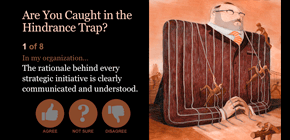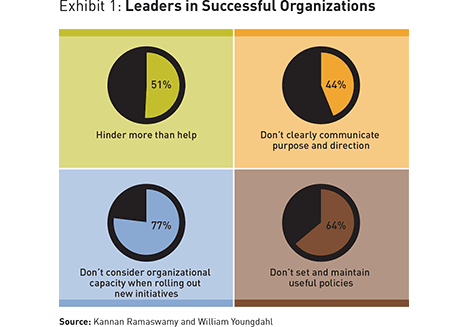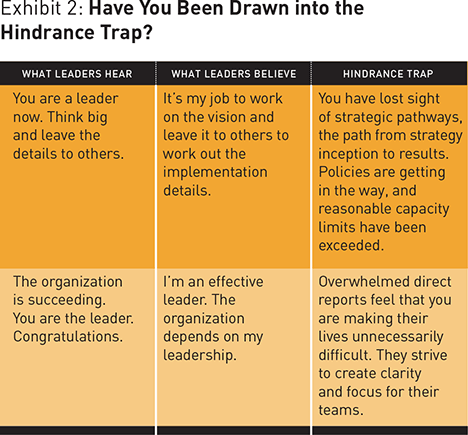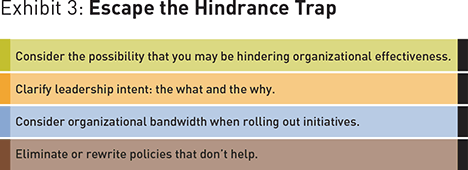Are You Your Employees’ Worst Enemy?
Many leaders inadvertently stand in the way of superior performance. Here’s how to avoid the hindrance trap. And to check your own performance, take our interactive survey.
(originally published by Booz & Company)In almost all organizations, some leaders pave the way for their employees to do their best work, and others inadvertently make things much harder than they should be. Where do you fall on this continuum? Do you help or do you hinder? In all probability, it’s the latter. According to our research, your employees are more likely to view you as an obstacle to their effectiveness than as an enabler of it—and that holds true whether your organization is successful or stumbling.
People expect to find bad bosses in failing companies. However, in surveys and interviews with more than 250 working professionals in 37 countries, we’ve found that 51 percent of employees across the full spectrum of organizational performance believe initiatives tend to succeed despite, not because of, their leaders. All employees think that their bosses hinder their effectiveness from time to time. But the prevalence of this phenomenon even in successful organizations (as defined by respondents to our surveys) is eye-opening.
It is hardly conceivable that the majority of bosses arrive at work each day with fresh ideas on how to actively scuttle the efforts of their teams. Rather, they are lured into what we call the hindrance trap—a cognitive bubble in which leaders erroneously conclude that the success of their teams is a reflection of their good leadership. As a result, organizations are settling for less than what they could achieve if they had more self-aware leaders throughout their hierarchies. The exact nature of the hindrance varies, but there are some common elements. They include a lack of clarity on purpose and direction, failure to consider the organization’s capacity, and useless policies (see Exhibit 1). Our research also indicates that leaders’ hindrance, left unaddressed, will eventually exact a stiff toll on employee engagement and morale, no matter how strong the latest quarterly report. To make matters worse, a pattern of hindrance will drive up the rate of churn among the highest performers. The average performers might silently suffer the consequences of a boss stuck in the hindrance trap, but high performers can hardly be expected to be as patient.
The good news is that any leader can escape the hindrance trap—or perhaps even avoid it altogether. It’s a process that begins with recognizing that hindrance is a real organizational disease, one with a set of specific symptoms you can diagnose. Only with an honest assessment can you plot your cure.
How Hindrance Takes Root
Falling into the hindrance trap is frequently a subconscious process. The trouble starts with the socialization of becoming a leader. As managers move up the ranks, they are encouraged to think big and leave the details to others. The result is often a disconnect between strategy conception and implementation. Some ideas that seem feasible in the C-suite simply do not work on the ground.
Leaders compound the problem when they fail to encourage honest, complete feedback from their employees. Such bosses believe they are helping because nobody tells them otherwise. They attribute success to their own efforts, when in fact the company’s positive results might be coming from self-motivated individuals making up for their leader’s shortcomings.
Variations of Hans Christian Andersen’s tale “The Emperor’s New Clothes” play out in organizations around the world. Few individuals are willing to point out the flaws of their bosses. Many employees may fear retribution. Others may not believe that it is their job to offer unsolicited developmental advice to their superiors. Our research shows that only 46 percent of leaders in successful organizations are perceived as supporting speak-up cultures. Thus, the lack of honest feedback is hardly surprising.
Strong performance results further mask the problem. When things aren’t going well, leadership behaviors tend to be readily highlighted as a root cause. But when results are positive, we tend to look the other way or simply don’t notice damaging behavior—and bosses see no reason to adjust their approaches or work on their own development.
Are You Trapped?
We know that leadership acculturation, lack of honest feedback, and the mask of success combine to draw many bosses into the hindrance trap (see Exhibit 2). The first step in diagnosis is therefore to pause for a moment and consider the way you lead. Have you reflected on the role that you play in helping your teams deliver positive performance outcomes? Do you proactively seek feedback from your teams about potential pressure points that line the pathways to successful strategy execution? Do you encourage constructive criticism of organizational norms and practices? Your answers to these introspective questions are one good way to assess your propensity to hinder your employees’ effectiveness.
Of course, validating your conclusions with those you lead is also critical. Reaching down and across the organization to solicit unvarnished feedback, both formal and informal, can help a leader gain a better appreciation of the realities on the ground. It’s best to turn to outsiders to help facilitate feedback about potentially hindering leadership behaviors. In our own experience, for example, we have concluded that individuals feel freer to speak with us about leaders who hinder them than they do to speak with their boss or an HR professional.
When looking for evidence of the hindrance trap, we focus on three key questions.
1. Are employees clear on the purpose and direction driving their work? Even in successful organizations, we found that only 56 percent of employees believed their leaders were providing clarity of purpose and direction.
When intent from the top is not clear, middle managers often create their own strategies to help focus resources on specific initiatives and activities. The assumptions embedded within the process of achieving clarity in the middle of the organization can lead to well-coordinated activities that head in the wrong direction. Positive results can pivot to disaster—sometimes without warning.
Consider the high-profile Deepwater Horizon incident that nearly sank BP. On April 20, 2010, the oil and gas giant reported a catastrophic failure at its Macondo well in the Gulf of Mexico. When all was said and done, 11 people had lost their lives and an estimated 4.9 million barrels of oil had seeped into the Gulf. Just nine days after the spill, BP shares had dropped US$25 billion in market value. By June 2013, BP had concluded its cleanup operations for Mississippi, Alabama, and Florida, but the cleanup of Louisiana continues today with no clear end in sight.
Although BP’s top leadership had previously identified safety as a key element of its corporate strategy, cost cutting emerged as the implied core value—and the key driver of people’s behavior. The incongruence first showed up in 2005, when a massive explosion at BP’s Texas City, Texas, refinery killed 15 people and injured 170, following cuts in preventive maintenance enacted in order to achieve aggressive financial goals. After the explosion, BP commissioned an independent panel, chaired by former U.S. secretary of state James Baker. The panel concluded that issues of management quality and lack of clarity in role definitions and responsibilities were largely to blame. Unfortunately, the lessons learned in Texas did not prevent the Deepwater Horizon spill. Once certain patterns of behavior take root, they can be frustratingly slow to change even after they have been identified.
2. Do our leaders account for and respect the need for the organizational capacity required to carry out their strategic intent? Even if leaders are clear on strategic intent, they can do more harm than good if they fail to consider the resources required to deliver results. We found that a mere 26 percent of employees in successful organizations believe their leaders account for organizational capacity when rolling out initiatives.
A project leader from a biotech company described the problem bluntly: “They keep asking us to do more and more with less and less, to the point that we will be doing everything with nothing.” This project leader shared a glimpse of her typical day. “I come home at about 7 p.m., feed my family, and put my daughter to bed,” she said. “By 9 p.m., I’m back to work at the computer until about 3 a.m.”
She was victimized by a senior leader who was caught in the hindrance trap, but she confided that she was also setting unrealistic expectations for members of her team who, in turn, experienced similar work–life imbalances. She had essentially become a hindrance trap conduit, assuming that others would also do whatever it took to live up to the often highly unrealis-tic expectations of the senior leader. Such extra unreported hours can hide the human costs of organizational success.
For some organizations, it has become the norm to expect employees to work on six projects at 20 percent each, in addition to fulfilling a range of day-to-day responsibilities. Overloaded employees sometimes deliver remarkable results and make their bosses look good for a season, but they cannot sustain these high levels of productivity. Over time, the quality of their work declines and initiatives miss important deadlines.
3. Do our policies promote or inhibit effectiveness? Leaders at all levels in the organization set policies that govern how decisions are made and executed. We found that only 36 percent of employees in successful organizations believe their leaders set policies that help the organization achieve superior performance.
In considering these results, it’s important to differentiate between types of policies. Those designed to ensure regulatory or safety compliance might not aid superior performance, but avoiding the consequences of being out of compliance makes them necessary. But that’s just one type of policy. Many others tend to be based on the personal preferences of senior leaders or long-standing tradition and may not reinforce current best practices. For example, a senior leader in a pharmaceutical company we studied instituted a 10-slide limit for PowerPoint presentations, ostensibly to focus attention on the important issues. However, he was unwilling to relax the expectation that presenters should be prepared to discuss fine-grained detail on any number of different issues when called upon to do so during their presentation. Anxious presenters were known to labor over getting their presentations down to 10 slides, while producing 100 backup slides to address whatever questions might arise. The process became a huge time and attention sink.
General organizational policies that address the unique “do’s and don’ts” of an organization can also be problematic. Often, these do’s and don’ts are nothing more than a historical record of the way the company has always functioned, or a codification of the organizational or industry practices that worked best in the past. However, over time such policies can become outdated and lose their relevance. In fact, many once-useful policies might actually evolve to undermine effective work practices. Leaders may unwittingly find themselves hindering progress if they stifle constructive criticism of organizational norms and practices.
Some readers may have heard stories about a study that illustrates the inertia of business policies. Researchers placed five monkeys in a cage with a set of stairs in the middle leading to a banana, which dangled high above on a string. Whenever any monkey tried to climb the stairs, the other monkeys were sprayed with cold water. Soon, no monkey could touch the stairs without violent opposition.
The researchers then removed one monkey and replaced it with an outsider. To the newcomer’s surprise and horror, all the other monkeys blocked its way to the banana. After two attempts and attacks, the new monkey gave up its quest for the banana.
Next the researchers removed another of the original five monkeys and replaced it with a new one. As expected, the newcomer went to the stairs and was pulled back. Joining the attack was the previous newcomer, who took part in the punishment with enthusiasm. One by one, all the original monkeys were replaced, until none had ever been sprayed with cold water. Nevertheless, no monkey ever again approached the stairs to reach the banana. As far as they knew, this was just “the way we do things around here.”
The three questions addressing strategic clarity, organizational capacity, and soundness of policies are crucial in identifying the extent to which leaders might be hindering more than helping. Leaders can’t afford to avoid these questions simply because they are achieving a high degree of success or because they may not like the answers. They need to consider how much better their people could perform with help rather than hindrance.
Planning Your Escape
Freeing yourself from the hindrance trap requires a certain degree of vulnerability (see Exhibit 3). You need to be willing to honestly examine your role in hindering or helping progress along an organization’s strategic pathways. At the risk of sounding like a 12-step program, the first step in escaping the hindrance trap is to recognize that you have a problem. Looking back at the disasters that struck BP under his watch, former CEO John Browne observed in his memoir, Beyond Business: An Inspirational Memoir from a Visionary Leader (Weidenfeld & Nicholson, 2010), “I wish someone had challenged me and been brave enough to say: ‘We need to ask more disagreeable questions.’” The challenge is to hone one’s self-awareness well before disasters strike.
Bosses caught in the hindrance trap frequently find out only after the damage has been done. But some enlightened leaders do have the self-awareness to discover, and the courage to admit, that they are getting in the way—and to take corrective action. Consider the case of Ralph Stayer, the CEO and cofounder of Johnsonville Foods. Stayer recognized that he had hindered the ability of employees to take on responsibilities and hold themselves accountable for positive performance. Of both his own transformation and that of Johnsonville Foods, Stayer wrote in First Person: Tales of Management Courage and Tenacity (Harvard Business School Press, 1996), “If I was going to fix what I had made, I would have to start by fixing myself.”
Stayer knew that changing company results would require a change in the way he led. Instead of simply declaring a new strategic direction, he sought more up-front engagement and accountability from those involved in the work of implementing those plans. Strategic intent was clearly communicated throughout the organization. He cut the layers of hierarchy from six to three, which helped ensure a shared understanding of the real organizational capacity required to deliver results. Revenues, margins, productivity, and quality all improved significantly.
Stayer admitted that he had been blinded by the earlier success and growth of Johnsonville; he believed success was the biggest obstacle to personal and organizational change. He realized that the control he had over the organization was misdirected and that he had become too removed from day-to-day realities as the structure of the organization had evolved.
Toward Clarity of Purpose
The second step in escaping the hindrance trap is to clarify leaders’ intent. If you are the CEO, then the solution focuses on you. If you are a leader somewhere in the middle of the organization, the solution focuses on both you and others. You need to seek clarity as much as deliver it.
Consider again the BP example, in which people at all levels of the organization struggled to make sense of two conflicting imperatives. Assumptions and competing objectives discounted the safety ethic in favor of making the numbers.
On the flip side, look at Apple. In Steve Jobs’s second term as CEO, Apple benefited hugely from his abundant clarity with respect to design, form, and functionality. During Jobs’s absence, the company had lost its focus, and along with it the true sense of what made Apple great. In his book Steve Jobs, biographer Walter Isaacson described how Jobs led his first product strategy review meeting by asking the assembled team a series of simple questions about what products he should recommend to his friends and what aspects of Apple’s history were evident in the designs the teams were working on. When clear answers were not forthcoming, Isaacson wrote (based on the recollections of one person at the meeting), “He grabbed a magic marker, padded to a whiteboard, and drew a horizontal and vertical line to make a four-squared chart.... Atop the two columns he wrote ‘Consumer’ and ‘Pro’; he labeled the two rows ‘Desktop’ and ‘Portable.’ Their job, he said, was to make four great products, one for each quadrant.... The room was in dumb silence.”
Jobs’s product development philosophy was the central engine that drove the company during its glory years. His almost unreasonable demands for design perfection have now become the stuff of legend. In retrospect, despite his other leadership limitations (some of which may well have hindered employees), it is evident that Steve Jobs had not only the necessary clarity and focus but also the ability to communicate it very crisply, and often very sharply, down the line so that everyone associated with the company clearly understood what was expected of him or her.
Aligning clarity of purpose and direction cannot be left to chance or to the variable strengths of different leaders down the chain. An organizational process is needed to drive alignment consistently throughout the organization.
The militaries of the world use a process called “commander’s intent” to ensure clarity of purpose and direction. A commander briefing his or her captains and lieutenants might say, “We need to take that hill and wait for reinforcements.” With that single statement of intent, the commander has made the purpose and direction clear.
After the subordinate officers have had time for initial planning, the commander reconvenes them and asks each one to share the statements being communicated to the troops and the broad outlines of their plans. These follow-up meetings create a degree of alignment that does not exist in many corporations.
We have worked with organizations to help translate commander’s intent into leader’s intent, a more palatable term for civilian organizations. Leader’s intent is a process for verifying alignment of purpose and supporting implementation plans at each handoff in the path from strategy to results.
Because leader’s intent provides clarity of purpose and direction, teams no longer waste time second-guessing unclear directives. They can spend their time and energy focusing on creative solutions to achieve results. Clarity removes the hindering effects of uncertainty.
Although leader’s intent should start at the top and become a common practice, midlevel managers can seek clarity of purpose and direction from those above and around them in the hierarchy. Managers should ask for a few minutes to present the purpose and direction they are sharing with their teams and the broad outlines of their implementation plans.
During these meetings, they can ask for feedback on their alignment with their own leaders. This approach is more productive than asking leaders to restate their unclear or unspoken statement of purpose and direction.
Saying No
The third step on the ladder of escaping the hindrance trap is accounting for the organizational capacity required along the pathways from intent to results. A good starting point is to decide which initiatives have outlived their usefulness and should be eliminated to make room for new programs. Heike Bruch and Jochen I. Menges make a strong argument for this approach in their April 2010 Harvard Business Review article “The Acceleration Trap.” Their notion of starting an initiative to kill initiatives resonates strongly. Far too many “walking dead” projects clog capacity in most organizations.
Once superfluous activities have been cut, leaders can allocate resources according to the priority of the remaining projects and initiatives. This requires the application of a consistent set of attractiveness criteria. Shape A/S, a highly successful Danish company that develops mobile applications, applies four criteria to all potential projects:
- Does the project include a feature set that will deliver value to the customer?
- Does the project provide interesting brand or marketing opportunities that deliver value to the company?
- Does the project suit the current human resources on the team?
- Does the client believe that the deliverable will be profitable?
On the basis of these criteria, projects are given red, yellow, or green status. As noted in “The View from Above: The Power of Portfolio Management” (Project Management Institute, April 2013), CEO Christian Risom allocates 80 percent of the company’s resources to pursuing projects that are rated green, even if it means saying no to big clients.
If the future of your company depends on the most important initiative, stop assigning people to focus on it only 15 percent of the time. Assign the right people to focus on the project full time, get it done, and then move on to the next project on the priority list. Effectively managing capacity means not just ensuring your employees aren’t overloaded, but ensuring that the right people are working on the right things at the right time. For example, you can use lower-priority projects as development opportunities for less experienced leaders. Proven high performers lose interest quickly in low-priority projects, but less experienced leaders will be eager to prove themselves.
Leaders don’t need to understand the complete details of how each project maps against organizational capacity. They do, however, need to be sensitive to the possibility that important new initiatives may conflict with existing workloads. Communicating clear intent, the “what and why,” isn’t sufficient for highly constrained organizations. Leaders must also state clear priorities and be willing to let go of some initiatives to make room for others.
No More Monkey Business
The fourth step in freeing yourself from the hindrance trap is to eliminate or rewrite unhelpful policies. Here, take a lesson from the monkeys that enforced their “no banana” policy because of the way things had always been done.
Two simple questions can help guide the process of eliminating or rewriting cumbersome policies. First, does the policy protect the organization from violating safety, legal, or regulatory standards? If the policy helps ensure compliance, leaders should still ask themselves if there is a better way to structure the policy to ensure compliance in the most efficient and effective way possible. Second, does the policy help focus talent and energy in ways that improve key business outcomes? If not, leaders should ask if the policy could be reconsidered.
For policies that do not involve compliance, it’s good to ask, “Is this a must-do or is it a preferred way of doing things?” One defense contractor implemented detailed policies on how to conform to certain government requirements. Before these policies were put into place, government auditors would simply assess the level of compliance to given product specifications. Once the company implemented these new policies, government auditors assessed the extent to which the company complied with product specifications and the extent to which the company complied with its own policies on how to achieve product specification compliance. The policy added significant product development time and resulted in an additional unintended consequence. The company could meet or exceed design specifications but still be out of compliance if it didn’t follow, to the letter, its policies on how to achieve compliance. Leaders recognized that the creation of such internal policies could be traced back to specific individuals reacting to isolated negative events that could be prevented through other means. Armed with this awareness, they began streamlining or eliminating certain policies in favor of achieving quality and compliance through a heightened focus on product and process design.
One of our client organizations has gone through an exercise its leaders referred to as “de-Dilberting” to eliminate as many policies as possible. Those that were deemed useful were then targeted for simplification. During the process, leaders realized that the origins of many policies could not be traced. Other policies had no mechanisms in place for ensuring compliance and no consequences for being out of compliance. In some cases, these issues reflected a lack of value, and the policy was dropped. In other cases, simple mechanisms were put in place to provide controls and measurement.
Staying out of the Trap
It can be challenging for individual leaders to get a clear picture of how they are hindering performance, especially when some of what they do is probably helping. Very few of us are pure helpers or hinderers. Asking the three guiding questions of yourself and other leaders is an important starting point. Using external facilitators to pose the questions to employee focus groups can also be particularly effective in identifying hindrance traps throughout organizations.
More broadly, organizations can administer surveys to create a map of their hindrance trap terrain. Keep it simple. Survey a comprehensive cross-section of employees at different levels in the hierarchy. Shape survey items to address strategic clarity and purpose, organizational capacity, and company policies. Design the survey to collect both scaled responses and open-ended comments, which often help in interpreting numerical responses. Look for patterns in responses that are suggestive of hindering behaviors.
In some cases, truly ineffective leaders might be flagged by the focus groups or broader surveys, and tough calls will have to be made. More likely, awareness of hindering combined with application of the straightforward approaches we have shared will yield rapid and significant benefits.
Are you willing to accept the possibility that others believe you are hampering their effectiveness? If so, you are starting an important journey toward staying out of the hindrance trap. ![]()
Reprint No. 00222
Author profiles:
- Kannan Ramaswamy is the William D. Hacker Chair Professor of Management at the Thunderbird School of Global Management and the founder/CEO of Leading Worldwide, a leadership consultancy.
- William Youngdahl is an associate professor specializing in strategy implementation and leadership development at the Thunderbird School of Global Management and the founder and CEO of a tech startup, 14falcons.
- The authors gratefully acknowledge Robert Herbold’s assistance in shaping their thinking on this article. Herbold served as chief operating officer at Microsoft and is now managing director of the Herbold Group LLC, a consulting business focused on executive training and profitability.






